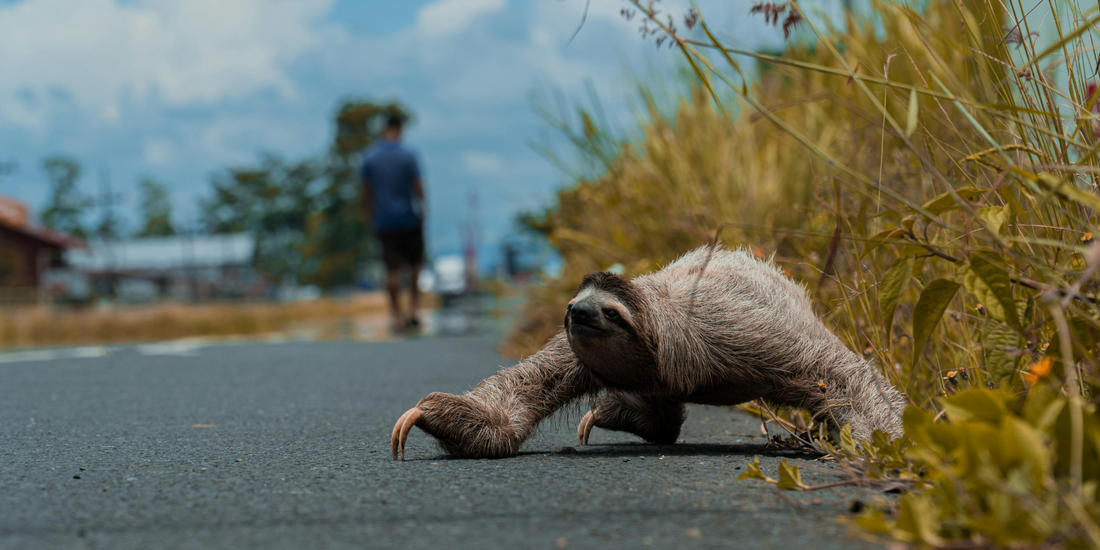
The Plight of Sloths: How Our World Is Changing Theirs
Share
In a world that seems to move faster every day, sloths remain a symbol of deliberate calm. But as the environment shifts beneath their claws, these gentle creatures are facing threats more urgent than ever. Today, sloths are not just slow-moving mammals in a rainforest—they are a warning. A canary in the tropical coal mine. Here's why.
1. Habitat Loss and Fragmentation
The lush rainforests of Central and South America once offered sloths a safe, continuous canopy—an aerial highway for foraging, sleeping, and avoiding predators. But that highway is breaking apart. Logging, agriculture, and expanding urban areas are turning their forest homes into isolated patches. When sloths are forced to descend from the trees to cross roads or pastures, they’re vulnerable to predators and collisions with vehicles.
Sloths are not built for the ground. Their curved claws and slow metabolism evolved for a life in the treetops. On the ground, they are virtually defenseless.
According to the Sloth Conservation Foundation, forest fragmentation has increased the likelihood of sloth-human conflict—especially electrocution from power lines and fatal encounters with dogs. Habitat loss is not just inconvenient; it’s lethal.
2. Electrocution and Urban Expansion
As sloths are forced into human-dominated spaces, they increasingly interact with infrastructure that doesn't account for wildlife. Bare power lines—often mistaken for branches—pose a deadly threat.
The Sloth Conservation Foundation’s Power Line Insulation project highlights that over 3,000 arboreal animals, predominantly sloths, are electrocuted every year in Costa Rica, with mortality rates approaching 70% due to severe internal injuries. While insulating these lines is a critical first step, it requires awareness, funding, and structural investment. No longer an engineering oversight, it stands as a glaring example of the urgent need for wildlife-compatible infrastructure.
You can see how severely this threatens sloths—the silent casualties of our expanding urban footprint.
3. Climate Change and Ecosystem Sensitivity
Sloths rely on the stability of their tropical rainforest habitat, where temperature and humidity ranges have remained relatively consistent over centuries. But climate change is shifting that baseline. Increased droughts, altered rainfall patterns, and rising temperatures are already impacting rainforest ecosystems.
Sloths, with their slow metabolism and very specific dietary needs (mostly leaves from select tree species), are not adaptive generalists. They cannot simply migrate to a cooler region or swap to a different food source. Their survival depends on the microclimates of their forests—and those are disappearing.
As noted in this peer-reviewed study via PeerJ, changing environmental conditions are reducing suitable sloth habitat and increasing the stress placed on already fragile populations. Climate change isn’t just melting ice caps; it’s reshaping entire ecosystems, one silent, slow-moving sloth at a time.
4. Endangered Status of Specific Species
Not all sloths face the same level of danger—but several species are on the brink. The pygmy three-toed sloth (Bradypus pygmaeus), found only on a tiny island off the coast of Panama, is critically endangered. Its habitat spans less than five square kilometers. Every tree lost matters.
Other species, like the maned sloth of Brazil, are also listed as vulnerable or endangered due to habitat fragmentation, deforestation, and lack of genetic diversity. These populations are small, isolated, and in decline.
The IUCN Red List continues to flag new concerns each year as monitoring efforts improve. But time is running out. Conservation can’t wait for convenience or popularity—it requires action now, when it's most needed.
5. Disruption of Biodiversity and Food Supply
Sloths are surprisingly influential in the web of rainforest biodiversity. They act as hosts for algae, insects, and even small ecosystems in their fur. They disperse seeds and contribute to tree health by their feeding habits. As sloth populations decline, so too does the balance of the forest.
Additionally, sloths rely heavily on certain tree species—like the cecropia tree—which are themselves impacted by logging, fire, and land conversion. A disruption to one part of the ecosystem inevitably affects the rest. The rainforest does not work in isolation, and neither do the species within it.
The World Wildlife Fund (WWF) highlights how these quiet creatures play a larger role than they’re often given credit for. Losing them would mean more than the extinction of a species; it would mean destabilizing the ecosystem that countless others depend on.
What You Can Do
If this all feels overwhelming, that’s okay. But sloths—and the forests they depend on—need more than awareness. They need action. Here are some ways to get involved:
- Support conservation: Organizations like The Sloth Conservation Foundation and the WWF offer ways to donate, adopt, or volunteer.
- Reduce your footprint: Limit your consumption of palm oil, beef, and soy unless sustainably sourced. These industries are directly linked to deforestation in the Amazon and beyond.
- Educate others: Share blogs, infographics, or conservation content that speaks to the issue. Knowledge is contagious.
- Advocate for wildlife-safe infrastructure: Encourage your city or country to adopt protective measures for tree-dwelling animals in areas of new development.
- Stay informed: Follow science-based organizations that provide updates on wildlife populations, threats, and policies.
Sloths don’t need sympathy. They need survival. And that depends on us.
If we want to preserve one of nature's most peaceful and peculiar creatures, we must learn to care—urgently, deeply, and with purpose.

